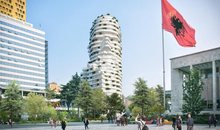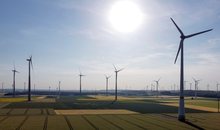
 Flash News
Flash News
Ceno Klosi with over 800 stolen votes, Balluku finds the reason is the tiredness of the counters
"Fast & Furious" in the former Block, police chase an Audi Q8, 4 cars collide
Car hits two tourists on a motorcycle in Fushe Arrëz, one of them dies
Serious accident in Thumanë, one dead, 3 injured
Durrës Court suspends the director of Pre-University Education from duty

Air pollution in Tirana exceeds the EU norm, which is also confirmed by local agencies. While Albania ranks first for the number of deaths as a result of exposure to ozone and nitrogen dioxide. From a comparison of the data, it results that the air of Tirana, where about a third of the population of Albania lives, is more polluted than 10 years ago. Experts explain how dust particles endanger the environment, but also the human body. They penetrate the respiratory tract and the blood, affecting the nervous system.
A year ago, the Mayor of Tirana, Erion Veliaj declared that the air quality in Tirana was at optimal levels.
"I'm here with you now and I'm launching Il Meteo and Copernicus provides the digital air quality system for every city. Tirana is 8 out of 10. When I remember 8 years ago that the same application gave us a complete red, 2, 3, 4, so not even a passing grade, clearly something has happened" - declared Veliaj on February 20, 2023.
To find out at what level the air quality is in Tirana, we addressed a request for information to the National Environment Agency, which we asked for data on the latest monitoring in the capital.
Referring to the data for the year 2023, KTA admits that Tirana exceeds the European Union norms for PM10 and nitrogen dioxide.
"From the monitoring that the National Environment Agency has already carried out over the years, it results that in the city of Tirana we exceed the European Union norm for PM10 (dust particles with dimensions of 10 microns) and NO2 (nitrogen dioxide), both of these indicators that come from the burning of fossil materials (coal, oil, gasoline, etc. at high temperatures), mainly from traffic", emphasizes KTA.

Environmental expert Olsi Nika explains the data provided by Faktoje, noting their absence for long periods of time.
"Ultimately, with so much data at your disposal, it can be said that the situation of PM 10 and PM 2.5 is problematic.
PM means solid particles suspended in the air (Particulate Matter) and the number 2.5 or 10 is their diameter measured in micrometers. (So 1/1000 of a millimeter).
These particles are very dangerous for the environment, but also for human health. In humans, PM 2.5 particles can penetrate the respiratory tract and the blood circulation system, affecting their normal and physiological functioning", argues Nika.
According to him, these particles have different sources, starting from the dust generated by inert materials such as constructions, engineering works, factories, to the slag generated by car exhausts, chimneys of factories, factories, TECs, etc.
Tabela më poshtë tregon parametrat optimalë të elementëve ndotës, sipas ekspertit Olsi Nika.

Raportet mbi ndotjen e ajrit në Tiranë
Një raport i Agjencisë Europiane të Mjedisit, publikuar në nëntor të vitit 2023 dëshmon se Shqipëria ka shkallën më të lartë të vdekjeve në rajon, për 100 mijë banorë, si pasojë e ekspozimit ndaj ozonit, që krijohet nga kombinimi i gazrave të dëmshëm që emetojnë automjetet nga mosdjegia e plotë e karburantit apo cilësia e dobët e tij, sidomos në ditët me temperatura shumë të larta.
I njëjti raport e rendit vendin tonë në krye të listës sa i përket vdekjes si pasojë e Dioksidit të Azotit për 100 mijë banorë, një substancë që prodhohet nga djegia e karburanteve fosile si gazi, qymyri dhe nafta.
Sipas po këtyre të dhënave, në periudhën 2017-2021 në Shqipëri kanë humbur jetën 5.410 vetë, si pasojë e ekspozimit afatgjatë ndaj PM2.5 e dioksidit të azotit dhe ekspozimit afatshkurtër ndaj ozonit.
Pasojat e ndotjes së ajrit në shëndet
Mjekët pneumologë argumentojnë se ajri, toka dhe uji i ndotur shkaktojnë çrregullime të gjithanshme, duke nisur nga sëmundjet e lëkurës, çrregullimet nervore, sëmundjet e aparatit respirator, kanceri, sëmundjet kardiovaskulare, sëmundjet hepatike, diabetike, endokrinologjike dhe të rrugëve urinare.
“Tendenca është në rritje. Shikoj gjithnjë e më tepër mosha të reja të ndikuara nga këto ndryshime. Të tërë jemi dëshmitarë, të paktën vizualë, të shtimit të sasisë së polenit në qytet. Nga ana shkencore, është provuar që ka një paralelizëm për sa i përket shtimit të dioksidit të karbonit dhe shtimit të polenit në ajër. Fenomenet alergjike janë shtuar në masë. Fëmijët me probleme që në moshë infantile mund të justifikohen deri diku nga ana shkencore nëpërmjet trashëgimisë, por nuk mjafton. Është përpara nesh fakti që ndotja jo vetëm është e pranishme, por edhe e shtuar ndër vite”, thekson mjeku Ardian Jorgji për Deutsche Welle.
Mjeku Ilir Alimehmeti rendit problemet e shëndetit si pasojë e përqendrimit të lartë të dioksidit të azotit, sidomos në kryeqytet.
“Dioksidi i Azotit shton vdekshmërinë nga sëmundjet kardiovaskulare dhe ato respiratore dhe përkeqëson astmën, infeksionet e frymëmarrjes dhe sëmundjet kronike të mushkërive”, tha Alimehmeti.
Cilësia e ajrit 10 vite më parë ‘më e mirë‘ se sot
Një raport i Agjencisë Kombëtare të Mjedisit në vitin 2014 tregon se edhe në atë periudhë kishte tejkalim të normave të BE për PM10. Mirëpo, shifrat sot tregojnë nivel më të lartë ndotjeje se para një dekade.
"It can be seen from the graph that we have exceeded the EU limit value of 40μg/m3 in three monitoring stations, the station of the National Environment Agency, the Ministry of Environment and Elbasan. All three stations are a source of traffic pollution, as the number of cars circulating on the roads near the stations is very high. At the KTA station, in addition to vehicle exhaust, road dust and construction also affect air pollution by PM10. The highest daily value was monitored in the month of April and is 142.55 μg/m3 from 50 μg/m3 which is the daily standard of the EU" - explained KTA 10 years ago.

High rates were also reported in 2014 for ozone, which also causes damage to the human body.
"High ozone levels can cause respiratory health problems by reducing lung function, worsening asthma and other lung diseases, and leading to premature death. Ozone is also a greenhouse gas, contributing to the warming of the atmosphere", explained KMA in the 2014 report.
Based on the official figures and the concerns of experts, it turns out that the air quality in Tirana is a danger to the health of the citizens and that the capital is no cleaner than a decade ago, on the contrary. Faktoje.al
Latest news





Lufta në Gaza/ Pse Netanyahu do vetëm një armëpushim 60-ditor, jo të përhershëm?
2025-07-02 21:56:08
US suspends some military aid to Ukraine
2025-07-02 21:40:55



Methadone shortage, users return to heroin: We steal to buy it
2025-07-02 20:57:35
Government enters oil market, Rama: New price for consumers
2025-07-02 20:43:30
WHO calls for 50% price hike for tobacco, alcohol and sugary drinks
2025-07-02 20:41:53







Israel agrees to 60-day ceasefire in Gaza, but many unanswered questions remain
2025-07-02 18:35:27
The weather in Germany is going "crazy", temperatures reach 40°C
2025-07-02 18:22:21

"Fast & Furious" in the former Block, police chase an Audi Q8, 4 cars collide
2025-07-02 17:59:25
"Birth on a tourist visa? US Embassy warns Albanians: This is prohibited!"
2025-07-02 17:48:16


BIRN: Fier recount reveals vote trafficking within open political party lists
2025-07-02 16:57:19

CEO and former director of 'Bankers Petroleum' arrested in Fier
2025-07-02 16:40:42
Car hits two tourists on a motorcycle in Fushe Arrëz, one of them dies
2025-07-02 16:33:23



Fire at the Elbasan Incinerator Landfill, Prosecution Launches Investigations
2025-07-02 15:34:54
What you need to know if you travel to a country with active volcanoes
2025-07-02 15:33:03



EU proposes 90% reduction in greenhouse gases by 2040
2025-07-02 14:50:23
Europe is burning from the heat / Italy and France are on maximum alert
2025-07-02 14:36:52

Moscow's contradictory statements: Is the friendship with Vučić breaking down?
2025-07-02 14:21:05
'I lost my battle': Sea warming is killing fishing in Albania
2025-07-02 14:08:35
Sekretet kimike që ndihmojnë në mbajtjen e mjaltit të freskët për kaq gjatë
2025-07-02 14:01:26

Denmark makes historic decision to make military service mandatory for women
2025-07-02 13:44:33
The appeal of the GJKKO leaves former judge Pajtime Fetahu in prison
2025-07-02 13:30:20
Productivity losses could reduce GDP by 1.3% as a result of extreme heat
2025-07-02 13:21:04
He abused his minor daughter, Zamir Meta is left in prison
2025-07-02 13:04:04

Waste burning in Elbasan, Alizoti: They are poisoning people and stealing money
2025-07-02 12:48:39
Civil disobedience continues in Serbia, dozens of people detained
2025-07-02 12:40:32
Rama's government was born under the sign of garbage and will end like this
2025-07-02 12:28:09
Water prices increase in the municipalities of the Elbasan region
2025-07-02 12:13:38
Civil disobedience continues in Serbia, what is happening in Belgrade?
2025-07-02 12:07:44
Serious accident in Thumanë, one dead, 3 injured
2025-07-02 11:54:42
Durrës Court suspends the director of Pre-University Education from duty
2025-07-02 11:49:27
Plenary session on Thursday, what is expected to be discussed
2025-07-02 11:36:43
Europe is burning from heat waves/ What is the 'thermal dome' phenomenon?
2025-07-02 11:26:25
Wanted by Italy for murder, 45-year-old arrested in Vlora
2025-07-02 11:19:31
Fire situation, 28 fires reported in 24 hours, 2 still active
2025-07-02 11:13:20
"Buka" file, preliminary hearing for Ahmetaj postponed to July 17
2025-07-02 11:03:30


Baçi: Belinda Balluku and Ceno Klosi, the most dangerous "gangs" in Fier
2025-07-02 10:32:09
Zamir Meta, suspected of sexually abusing his daughter, arrives in court
2025-07-02 10:21:33

Trump: Israel has agreed to a 60-day ceasefire in Gaza
2025-07-02 10:01:55
Fire continues at Elbasan landfill
2025-07-02 09:51:13

Dates to note during July, important events will occur
2025-07-02 09:31:45
The hearing for Jorgo Goro's claim is postponed
2025-07-02 09:24:19



Foreign exchange, the rate at which foreign currencies are sold and bought
2025-07-02 08:42:31

52% of pensioners did not receive full pension in 2024
2025-07-02 08:27:18
Horoscope, what do the stars have in store for you today?
2025-07-02 08:13:36
Hot weather, Wednesday brings high temperatures
2025-07-02 07:59:16
Morning Post/ In 2 lines: What mattered yesterday in Albania
2025-07-02 07:46:15
Heatwave sweeps across Europe, Spain and England record hottest June ever
2025-07-01 22:57:41






Golem and Qerret without water at the peak of the tourist season
2025-07-01 21:09:32

Euractiv: Italy-Albania migrant deal faces biggest legal challenge yet
2025-07-01 20:53:38
BIRN: Brataj and Fevziu victims of a 'deepfake' on Facebook
2025-07-01 20:44:00

Vlora by-pass, work delays and cost increases
2025-07-01 20:24:29



Milan are expected to give up on the transfer of Granit Xhaka
2025-07-01 19:41:25

